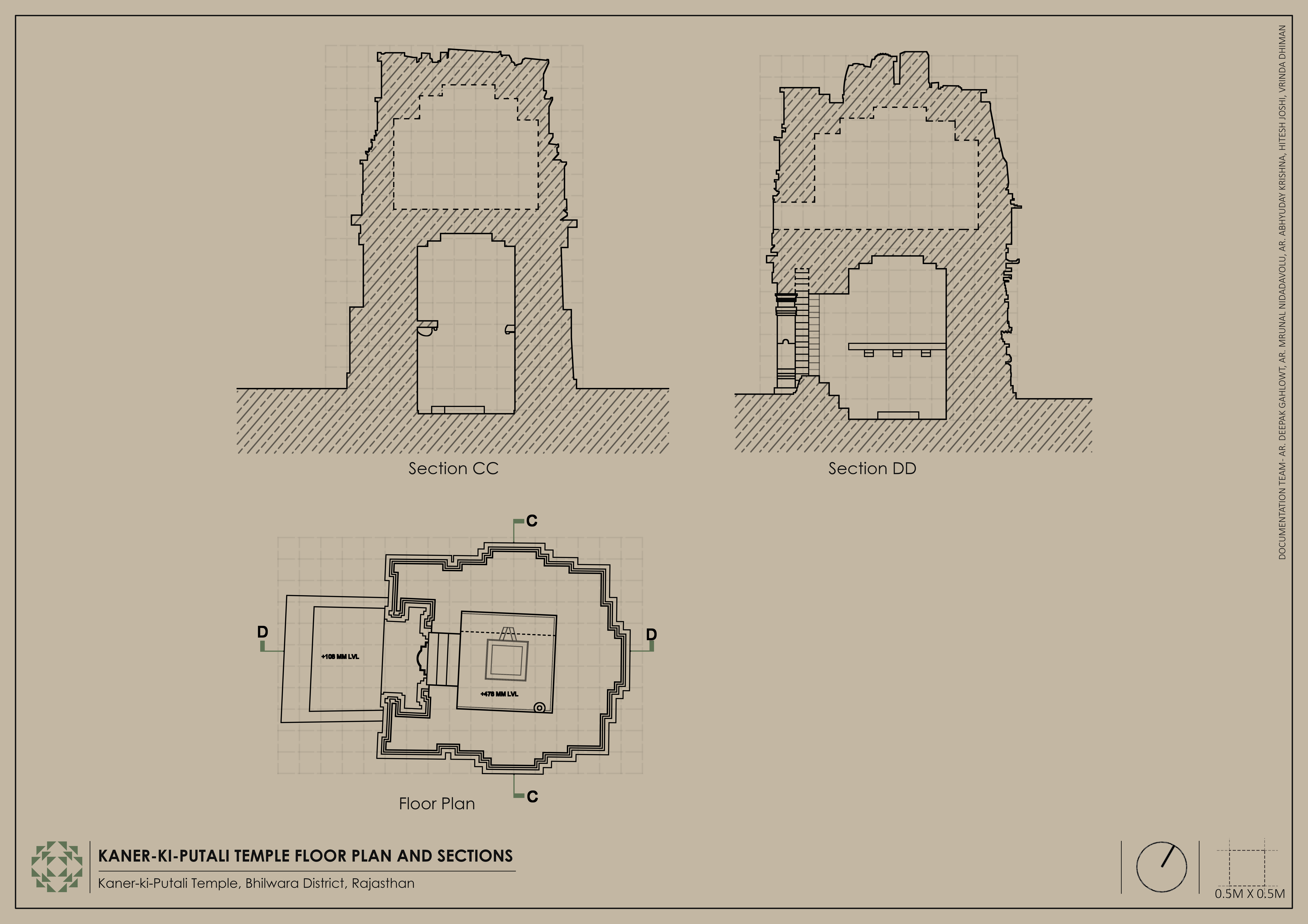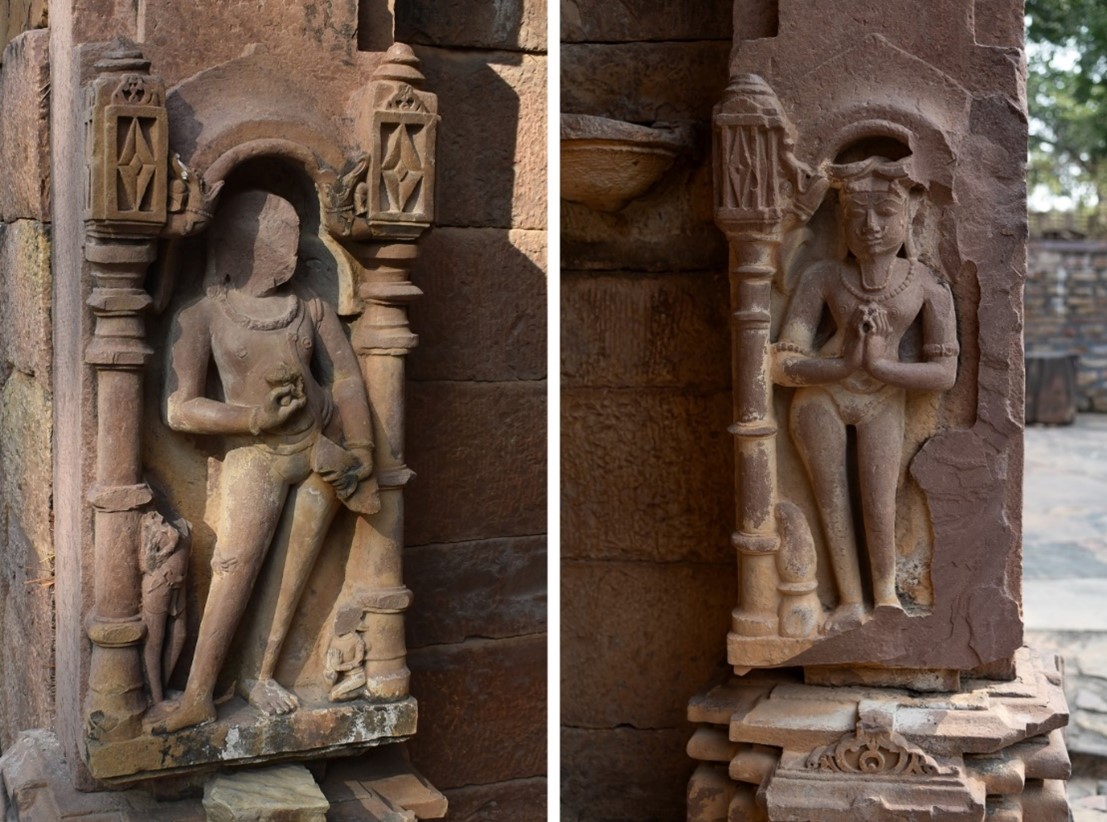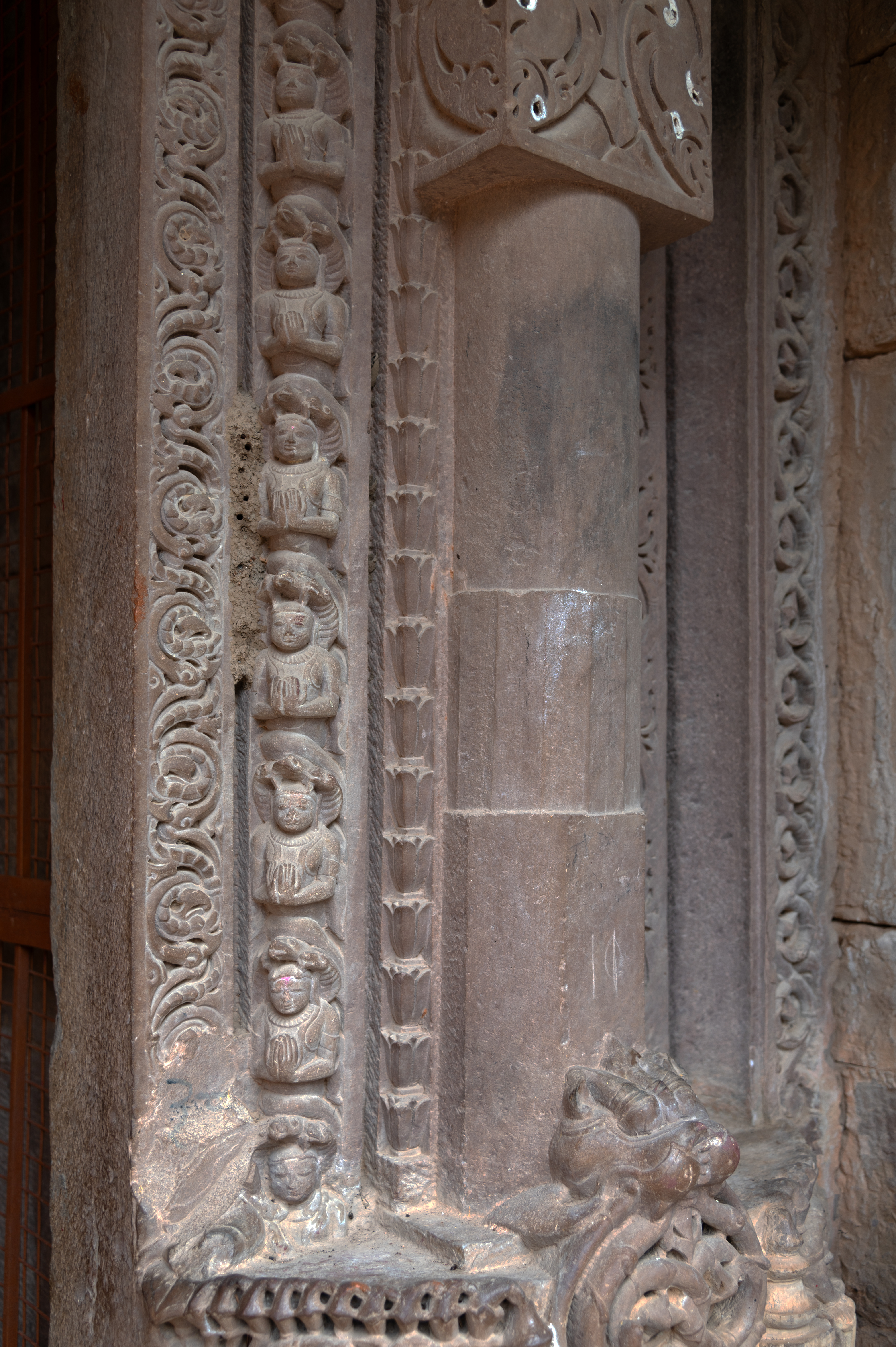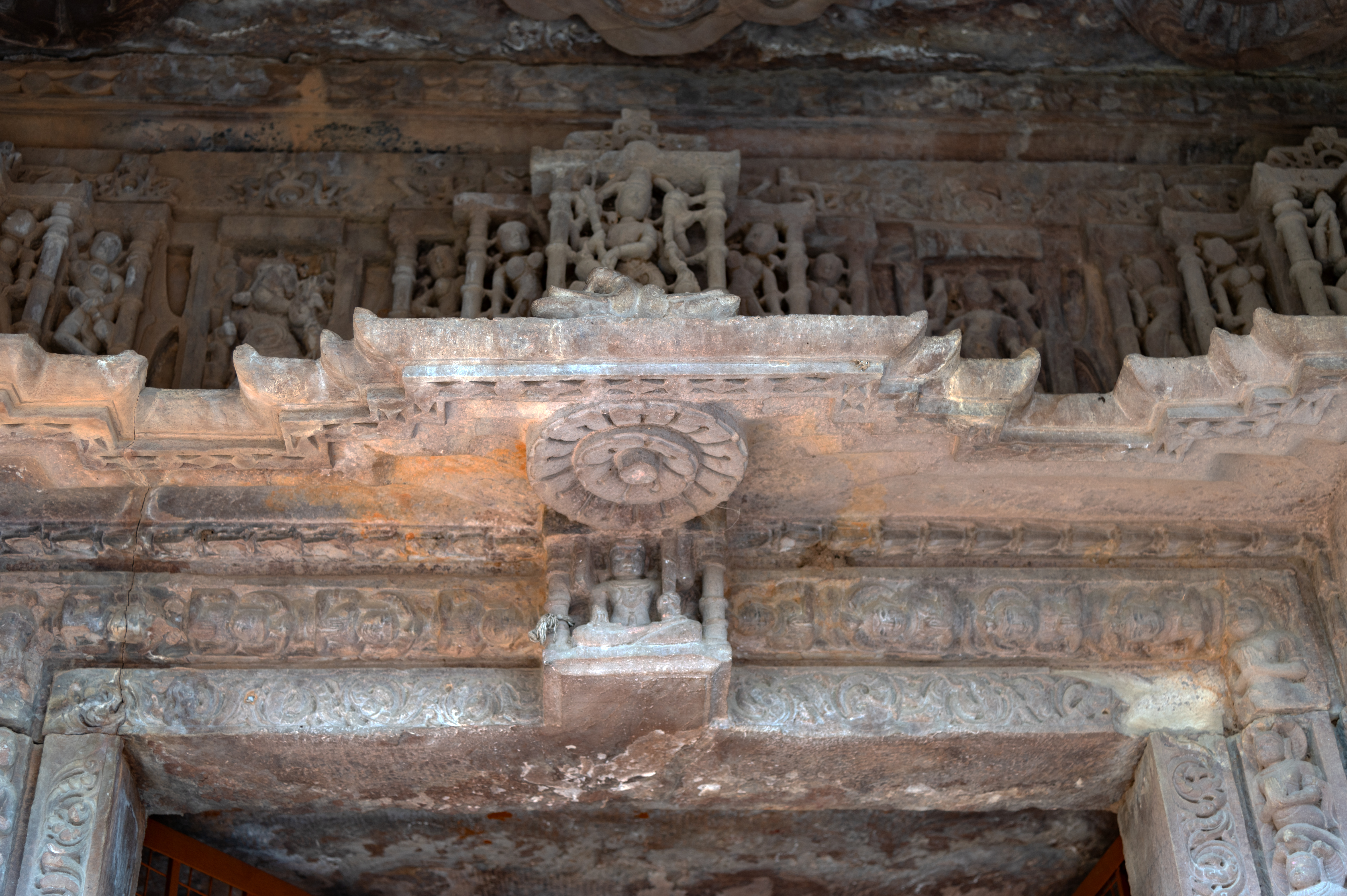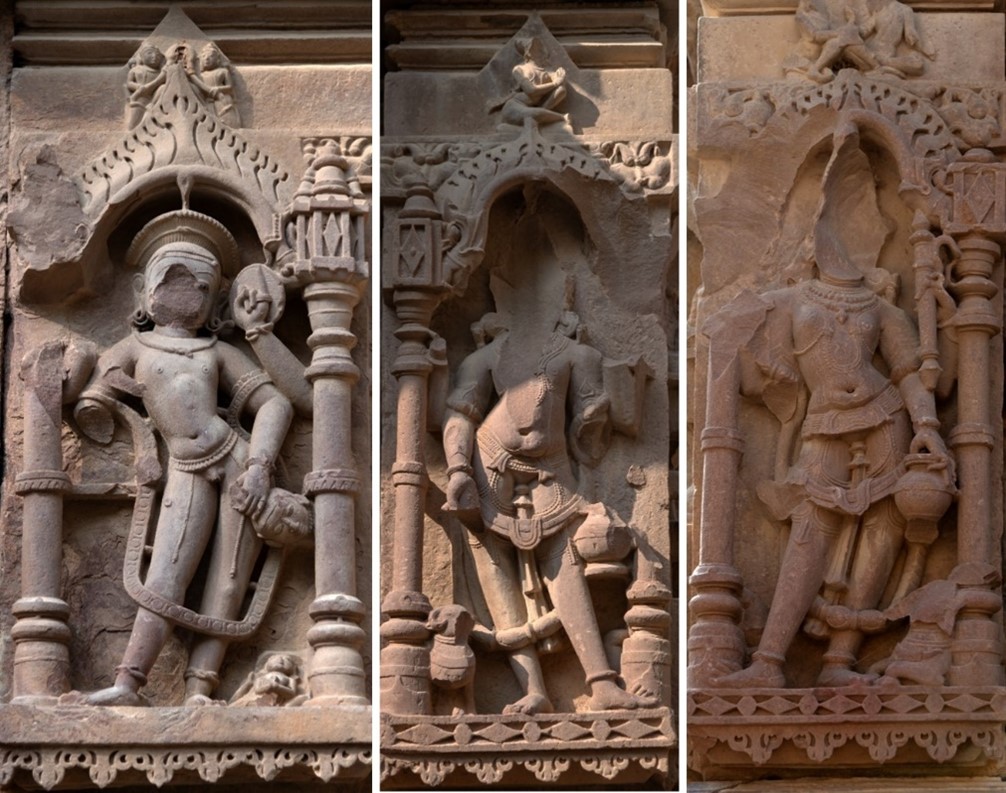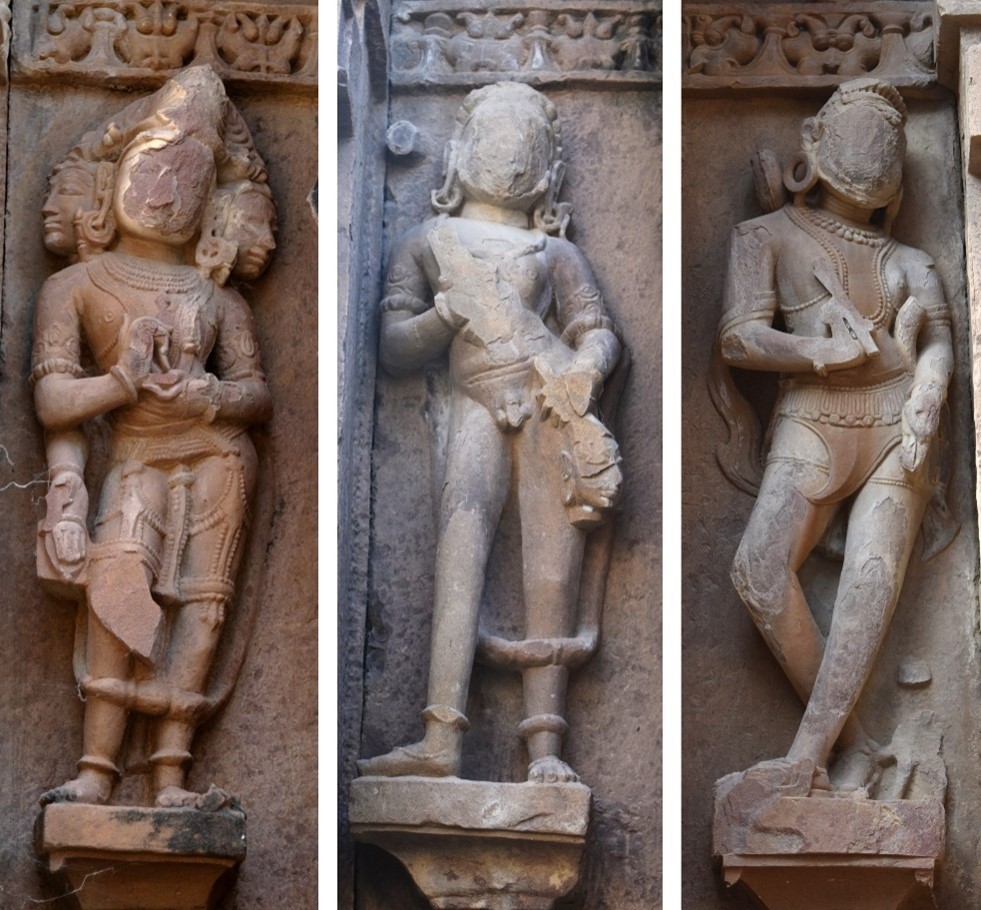Kaner-ki-Putli: An Unseen Bhumija Temple of Bhilwara
Kaner-ki-Putli (Image 1) is a Shiva temple situated in the Khadirpur locality of Bijolia in the Bhilwara district of Rajasthan. The temple is situated in a valley created by water erosion of the rocks in the Vindhya range. [1] It is nestled in a secluded region, locally known as Kharen, near a stone quarry and exudes an air of tranquillity and mystique.
Dedicated to Shiva, Kaner-ki-Putli Temple is oriented west and is currently comprised of a garbhagriha (sanctum santorum) and antarala (vestibule), while the mandapa (pillared hall) has collapsed (Image 2). The structure includes basal mouldings and intricately carved jangha (walls), but unfortunately, the upper section of the shikhara (superstructure) has sustained damage over time. Stylistically, the temple belongs to the 12th century CE. Protected under the Jaipur Circle of the Archaeological Survey of India (ASI), it has undergone restoration (Image 3), and some of the architectural elements and sculptures are in the storage of another protected temple site at Menal, Chittorgarh district. However, beyond the damage, the temple has also fallen victim to theft. According to the list of stolen antiquities from the Centrally Protected Monuments, Sites, or Museums maintained by the ASI from 2010-2014, four sculptures from Kaner-ki-Putli were reported as stolen, and, unfortunately, these sculptures remain unrecovered to date. [2]
Kaner refers to the flower buds of the Kaner plant, scientifically known as Nerium oleander. The plant is a shrub known for its evergreen leaves and colourful, fragrant flowers. The flower buds, or putli in Hindi, are the small, unopened flower clusters of the plant. Regrettably, the route to the temple and its surroundings fails to evoke the imagery implied by its name. The Kaner-ki-Putli Temple is one of the lesser-known temples of Rajasthan and has received minimal attention in academic studies, primarily due to its isolated location. Providing firsthand information, the temple's brief in the Progress Report of the Archaeological Survey of Western India highlights this oversight. As per the brief, the temple is located in the village of Brindavana, near Bijolia. It describes certain key features, such as the sculptures on the lalatabimba (lintel), the uttaranga (entablature) of the doorframe, and a three-headed deity[3]. However, it lacks comprehensive documentation of the rest of the temple's structure and sculptures. It notes that the shikhara of the temple appears unfinished. [4] This limited documentation underscores the need for a more thorough study to fully appreciate the temple's artistic and historical significance.
J P Joshi and Krishna Deva briefly discuss Kaner-ki-Putli in their Inventory of Monuments and Sites of National Importance, a significant work that addresses existing gaps by providing additional information about the temple. They identify the temple as an example of 12th-century Bhumija-style architecture and include a detailed plan of the site, highlighting its dedication to Lakulisha. [5] R. V. Somani also mentions the temple in the Temples of Rajasthan but does not contribute new information. [6]
This temple, though simple, holds significant value for understanding the Bhumija style of architecture in Rajasthan. The temple is small but has an ornately carved doorframe and profusely carved jangha. It has exquisite sculptures of Shiva and other deities, including Kartikeya, Bhairava and dikapalas (deities of the cardinal directions), along with numerous depictions of ascetics and beautiful surasundaris (celestial damsels). A detailed description of this temple is necessary as a reference point for future studies.
Interior of the Temple:
The Kaner-ki-Putli can be entered through the entrance of the antarala (Image 4), which has two square-shaped pilasters. These pilasters are carved with male figures at the bottom with ornamentation on the top. The pilaster on the right has a male figure whose face has been lost to damage (Image 5). His upper body is bare, and he wears a short langot (loincloth) to cover his lower body. He is depicted with two arms and holds an unidentified, broken object in his right hand near his chest. His left hand also holds an unidentified object. The figure is adorned with a necklace, broad yajnopavita (sacred thread), and bracelets. There is another small standing figure on his right that is presently headless. The figure is wearing a small dhoti (a loose piece of clothing wrapped around the lower half of the body) and has a dagger tied at his waist. On the left, there is a small, seated figure with folding hands in veneration to the central figure. It is hard to identify the figure due to the damaged face and attributes, but it appears to be an important figure accompanied by a guard and a devotee.

The pilaster on the left shows an ascetic standing with folded hands (Image 5). He has a heavy jatabhara (matted hairdo) and a long beard and moustache. His torso is bare, and his lower body is covered with a langot. He is wearing a necklace that might be made of rudraksha (dried stones or seeds of the Elaeocarpus ganitrus associated with Shiva iconography) and a similar kind of armband on his right arm. His left arm is also adorned with a broad armband. There is a water pot at the bottom with a foliage motif. There are bharavahakas (weight-bearers) at the top of both pilasters. One of the bharavahaka is shown playing the flute, while the other is playing cymbals.
The antarala is a very shallow area with its floor completely covered with the moonstone carved outside the door of garbhagriha. The lateral walls of the antarala are devoid of niches or any other decoration. The antarala leads to the garbhagriha, which has a well-decorated saptashakha (seven vertical branches or bands) doorframe (Image 6). The bottom part of the doorframe shows Shaiva dvarapala (door guardian) and female figures. The upper portion is adorned with various decorative motifs. The first shakha is carved with a floral design, and the second shakha is carved with the nagas (serpents) arranged vertically (Image 7). They are shown with human faces and bodies and have three hoods over their heads. They are all represented with folded hands in veneration. The third shakha is decorated with a floral design, and the same motif is used to adorn the fifth shakha. The fourth shakha is a stambhashakha (pillared branch), which shows a hexagonal pillar that turns faceted and then becomes circular (Image 7). The top of both pillars has a square abacus topped with circular mouldings and purnaghata kalasha (vase of plenty). The sixth shakha is adorned with curvaceous floral meandering, and the last shakha is also carved with a floral band.
The lower portion of the garbhagriha doorframe of the temple shows the river goddesses Ganga and Yamuna (Image 8). The faces of both goddesses have been damaged, along with one hand on each sculpture. The goddesses are adorned with jewellery and are shown standing with one of their hands placed on their waists. Their vahanas (mounts) are also damaged, but on the right side, the remains of broken makara can be seen, which suggests that the goddess is Ganga. The figures next to the river goddesses represent Shiva (Image 8). On the right, there is a four-armed figure of Shiva holding a khatvanga (a staff with a human skull) and a sarpa (snake) in his upper hands. His lower right hand, carrying an akshmala (rosary), is held in varada hasta (boon-giving gesture). In his lower left hand, he is holding a bowl. He has a jatamukuta, and he is heavily ornamented. There is a depiction of Nandi at the bottom left, which is now broken. The figure on the left also has four arms and carries a trishula (trident) and damru (hourglass-shaped drum) in his upper hands (Image 8). In his lower left hand, he is holding a beejapurak (fruit), and his right hand is making the varada hasta. He has a jatamukuta with a crescent moon at the centre. There is a Nandi seated at the bottom right.
The figure next to the Shiva represents female attendants, and the figure on the end is Kubera. Kubera is depicted with two arms on both sides and holds a money bag. He wears a karanda mukuta (conical, multi-tiered headdress or crown) and is adorned with jewellery (Image 8). The lalatabimba has a figure of a seated Lakulisha in padmasana (lotus pedestal pose) (Image 9). He holds a lakuta (staff) in his left hand and a beejapurak in his right hand. He has an erect phallus.
There is a uttaranga above the lintel representing the divine figures of Nataraja at the centre, Brahma on the extreme right and Vishnu on the extreme left (Image 9). There is a figure of Ganesha in between Shiva and Brahma, and there is another deity in between Shiva and Vishnu. They all are flanked by the female chauri (fly whisk) bearers.
The central figure of Shiva in the form of Natesha (Image 9), is one of the most beautiful figures in this temple. The size of the figure is small, but the sculpture captures the divine dance in the most captivating manner. Shiva is shown dancing to the beat of the drum played by the drummer at the bottom. He is accompanied by Nandi, sitting at the bottom left. Shiva stands with his left foot firmly placed on the ground and the right raised upward and pointing inward. He holds a snake in his upper arms and a damaru, a khatvanga, a bowl, a trishula, and a kamandalu (water pot) in his other arms.
To the right of Natesha, Ganesha (Image 9) stands holding a battle axe with his broken tusk and a bowl of modaks (a type of sweetmeat). Next to him is Brahma, depicted with three faces and four arms. He has a shruka (a spoon used in performing sacrifice) and a pustaka (manuscript or book) in his upper hands. One of his lower hands is holding a kamandalu while the other is in varadaksha (handheld in varada hasta with a rosary).
To the left of Shiva, a four-armed deity is shown standing, holding a gada (mace), and making varada hasta. He holds two other unidentified attributes in his upper hands. Next to him is the figure of Vishnu, shown holding a gada, a shankha (conch), and a chakra (discus). One of his lower hands is making the varada hasta. He is wearing kiritamukuta (a cylindrical crown associated with Vaishnava iconography) and jewellery.
The garbhagriha is a small square chamber with a Shiva linga at the centre (Image 10). The yonipatta (womb-shaped base) of the Shiva linga is square instead of the usual circular shape. The walls of the garbhagriha are completely plain, and there is a pranala (water discharge outlet). The ceiling of the garbhagriha is square and comprised of a square within a square, decorated with a flower at the centre.
The Exterior of the Temple:
The temple stands on a high-raised vedibandha (basal mouldings). Due to the restoration work, a few of the base mouldings have been covered in the ground. The moulding includes kapotapalika (cyma recta), kalasha (pitcher-shaped or tourus moulding), grassapatta (band of kirtimukhas or face of glory motif) and patta (band) carved with jala from bottom to top (Image 11). Above these mouldings, a kumbha (high basal moulding with pot-shaped or curved shoulder) is placed that is carved with the figures of deities and a ratnapatta (band of diamond-shaped motifs). Above the kumbha and kalasha, antaralapatta and kapotapalika is carved.

Shiva and Vishnu are represented on the kumbha moulding. Shiva is shown seated on Nandi. He is depicted with four arms. Two of his upper arms hold a trishula and a sarpa. His lower right hand is held in vardaksha. His lower left hand is holding a phala (fruit). He is shown wearing a jatamukuta and has a diamond mark on his chest.
Vishnu is also shown in a niche, seated on a pedestal. The sculpture is damaged from his face and chest, but all his arms are intact. He is holding a gada and a chakra in his upper two hands. In his lower left hand, he is holding a sankha, and his lower right hand is in varada hasta.
The jangha of the temple (Image 11) has projections and recesses. The bhadras or central offsets of the garbhagriha have niches that were installed with the figures of deities. Currently, all the bhadras on all three sides are empty. The rest of the projected and recessed parts are carved with minor deities such as dikapalas, Shaiva ascetics, and a few female figures.
The shikhara is damaged, and the upper portion of the shikhara has collapsed, leaving the lower part intact (Image 11). A close study of the shikhara reveals that it was a Bhumija shikhara with latas (central offsets) in the cardinal directions, and in between the latas, kutas (miniature shikharas) are arranged in rows. The central offset is plain at the base and has a decorated pediment above. The rest of the lata is intricately carved with chaitya arch jala. The intermediate space between the latas is filled with two rows of kutastambhas (vertical rows of miniature shikharas). On the southern side of the shikhara, three kutas are intact. The lower kutas are profusely carved with chaitya arch jala, while the upper two are plain and simple.
The front façade of the shikhara is carved with niches decorated with large diamond motifs. There were two sculptures on either side of the lower niche (Image 3), but presently, both sides are entirely plain. The visual archive of the ASI shows that there were figures of Maheshwari and Vaishnavi in these two places. Maheshwari was installed on the right side of the niche, and Vaishnavi was placed on the left. Both goddesses are depicted as four-armed. Maheshwari held a trishula and a sarpa in her upper hands and a kamandalu in her lower hand. Her other lower hand was in varada hasta. Similarly, Vaishnavi had a chakra and a gada in her upper hands, and in one lower hand, she held a kamandalu while the other was in varada hasta.
Sculptures on the Jangha: Dikapalas and other minor deities
Nirutti: Standing inside a niche on the southern wall, a four-armed depiction of Nirutti (Image 12) holding a shield in his upper left hand and a human skull in his lower left hand. His right arms are broken. Nirutti is shown nude with an erect phallus that is presently damaged. He has a unique high, raised hairdo. Unfortunately, his face is badly damaged, and none of his facial features are visible. It is noteworthy that Nirutti is shown wearing jewellery shaped like snakes—coiled around his wrist, neck, and ankles to create the bracelet, necklace and anklet. His earrings are also made of snakes. A beautiful waistband is tied around his waist, and a beaded loop can be seen falling from his waist to his thighs. At the bottom of the niche, one can see a figure with legs raised backwards in the air. This figure is shown with folded hands.
Agni: A male figure is shown standing in a niche on the corner of the southern wall (Image 12). The figure is damaged, and his head has been completely lost. His upper arms are broken, and in his lower hands, he holds a kamandalu in his left hand and his right hand is in varada hasta. At the bottom of the niche is a broken animal with horns, which can be identified as a ram. Based on the vahana, attribute, and gesture, this figure can be identified as Agni whose vahana is a ram and who holds a kamandalu.
Indra: Indra is depicted in one corner of the east wall (Image 12). Indra’s face has been chipped away and his right arms are broken. In his upper left hand, he holds an ankusha (bull hook), and in his lower left hand, he holds a kamandalu. He is wearing jewellery and is accompanied by an elephant. The face of the animal is broken, but a closer look at the animal’s leg and foot shows that it is an elephant, Airavat.
Ishana: Another male dikapala can be seen on a corner of the south wall of the garbhagriha. The four-armed deity, like the other deities, has been damaged. His face is missing entirely, and three of his arms are broken. This dikapala holds a trishula in his upper right hand (Image 13). At the bottom of the depiction is a bull. This figure could be of Ishana, whose vahana is a bull and is frequently shown holding a trishula.
Kubera: The figure of Kubera is installed in the corner of the north wall (Image 13). The depiction of Kubera is in karanda mukuta and adorned with heavy ornaments. In his lower left hand, he holds a kamandalu, and in his upper left hand, he holds a money bag behind his head. It is interesting to note that here, Kubera is not shown with his vahana, but there is a pot placed at the bottom of the niche, which represents wealth.
Vayu: On the other end of the wall with the depiction of Kubera, the figure of Vayu (Image 13) is represented in a niche. This figure’s head and arms have been damaged, but there are still details that can be gathered from his face. The beautiful, young Vayu is depicted holding a staff with a banner in his upper right hand. The banner can be seen behind his head. His lower right hand holds a rosary and is in Varada hasta. At the bottom is a carving of an antelope, the vahana of Vayu.
Three-faced deity or Atiriktanga Bhairava: Near the figure of Vayu, on the north wall of the garbhagriha, is the figure of a male god, represented by three heads that have jatamukutas (Image 14). He had four arms, but currently, only three remain. In his front hand, he holds a bowl close to his chest, and with his other hand, he is touching the bowl. His third hand is in varada hasta.
Unidentified male deity: There is another male deity whose face has faded away. He is depicted with two arms and is holding a human skull in his left hand. The attribute in his right hand is broken and cannot be identified (Image 14). The deity has curly hair, a beard, and long ears adorned with earrings. He is wearing a long garland and other jewellery. His phallus is shown erect. The iconography suggests that this figure might be of Bhairava.
A foreigner?: There is a male figure that looks distinct from the rest of the male figures carved on the walls of the garbhagriha. The figure has a curly raised hairdo and a beard. The face of the figure has been damaged beyond recognition. His upper body is bare and adorned with jewellery. His lower body is wrapped in a distinct, triangular loin cloth (Image 14). The figure wears an antahavastra (inner garment) below his loin cloth. He is carrying a scarf wrapped around his arms. He has two arms in which he was once holding something, but now, the object is broken and cannot be identified. Only the middle part is visible, and it looks like a stick. It is noteworthy that this figure is the only figure shown wearing footwear. The different styles of attire and footwear suggest that the figure is the representation of a foreigner.
There are figures of many Shaiva ascetics on the external walls. The figure of Lakulisha on the lalatabimba and the frequent portrayal of Shaiva ascetics suggest that the temple was dedicated to the Pashupata sect of Shaivism and might have been a significant site for them. There are a few sculptures of surasundaris performing different activities, such as nurturing a baby, holding a water pot, etc.
Footnotes:
[1] Joshi and Deva. Inventory of Monuments and Sites of National Importance Volume II, Part I, 66.
[2] Statement giving details of the theft of antiquities from Centrally Protected Monuments/Sites/Museums maintained by the Archaeological Survey of India during the last five years from 2010-2014. https://asi.nic.in/pdf/D.G.-fresh2.pdf
[3] Identified as Atiriktanga Bhairava by K.L. Mankodi. To What God Shall We Render Homage in the Temple at Modhera? Franco-Indian Research Pvt. Ltd. 2022.
[4] Progress Report Archaeological Survey of Western India, Government of Bombay, 1905, 54.
[5] Joshi and Deva, 66.
[6] Somani, Temples of Rajasthan.
Bibliography:
Archaeological Survey of India, Jaipur Circle. Kaner Ki Putali. Archaeological Survey of India. n.d. https://asijaipurcircle.nic.in/Conservation%20in%20KAner%20ki%20Putali.html
Joshi, J. P., and Deva, Krishna. Inventory of Monuments and Sites of National Importance Volume II, Part I, Jaipur Circle. New Delhi: Archaeological Survey of India: 2006. https://ignca.gov.in/Asi_data/88329.pdf
Mankodi, K.L. To What God Shall We Render Homage in the Temple at Modhera?, Franco-Indian Research Pvt. Ltd. 2022.
Progress Report Archaeological Survey of Western India, Government of Bombay, 1905.
Somani, R. V. Temples of Rajasthan. Jaipur: Publication Scheme, 2012.

